July Japan travel seasonal highlights, themes, and attractions

July Japan travel is a unique month and not really a high-season month, more like in the middle between peak and low. July is a month (as is much of August), when Japanese kids get out of school and big domestic summer vacations are popular throughout the country). In the foreign July Japan travel season there are few visitors from North America (since summer is perfect at home) but many from Europe (Spain and Italy, especially) and lots from Southeast Asia. For Southeast Asians Japan July-August summer heat and humidity (at sea level) is no different from home and thus not a deterrent. July Japan travel is all about timing, knowing where to escape the city heat on day trips and the wonders of the higher altitudes in Kyushu and from Kyoto to Tokyo. Plan ahead but don’t worry too much about crowds (except in Kyoto around the middle of the month, Gion Matsuri).
Japan travel in July (and much of August) at sea level is extremely hot and humid and temperatures of plus 35 C (95 F) are common. However, there are ways to make sure that your Japan summer trip as pleasant as possible. To begin with, it’s a good idea to get up early in the morning. In July the sky begins to get light around five in the morning. And from 5:00 to 10:00, when it’s still cool, fresh and comfortable, is best part of the day to wander and explore in city settings at a sea level.
The day gets unbearably hot by around ten and stays that way until just before sunset. The hottest part of the day is between noon and three. Once the sun sets, the things cool down considerably. Taking a “siesta” in your air-con rooms or in the best air-con settings is a good way to process the morning experiences and slow down a bit before going out again around sunset as the evening magically cools. Day trips to higher elevations from Kyoto, Tokyo or Osaka are easy and each city has at least three or four excellent options. The best are: 1. Mount Hiei and Kibune and Shiga (from Kyoto). 2. Hakone | Mount Fuji or Lake Kawaguchiko | Mount Fuji and Nikko (from Tokyo). 3. Nara, Wakayama (Mount Koya), Mie Prefecture (from Osaka).
On July evenings, in the Old Capital, Kyoto, the banks of the Kamogawa River offer a great place to cool off. The area between Shijo and Oike is particularly popular with young couples, who sit at intervals so regularly spaced that you might think someone had measured them out. One riverside experience that everyone should try is yuka dining. Yuka are large wooden dining platforms that extend out from restaurants on the west side of the river between Gojo and Oike. These open-air dining areas are unique to Kyoto. Yuka developed in the 16th century. In the beginning they were nothing more than a place where you could eat outside: wooden benches placed along the side of and sometimes in the Kamogawa River. Here, people brought their own food and drink, which they enjoyed while sitting near the water, with some of the lower classes probably going so far as to dip their feet in the river. A similar form of outdoor river dining is also to be found in Kibune (just north of Kyoto by tram) which also begins in May (to late September)
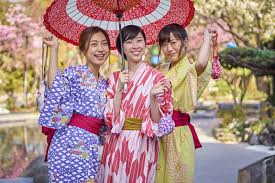
Summer, from about mid-July to early August, is also known for chugen, an age-old tradition of gift exchange practiced by businesses and families alike. In the food sections of all the department stores and at supermarkets too, you will see a great number of things especially packaged for summer gift giving. Popular items include beer, juice, soap, towels, fruit, and other food items.
A natural summer wonder worth looking for is the lotus or hasu. The flower struggles, as we do, to rise out of the light forsaken muddy depths and shine forth in a breath-taking show of pink or white flowers. Lotus flowers open at dawn and close by noon. On another level, the short-lived lotus is a symbol of reincarnation: the wheel-like leaves and spike-shaped petals suggest the endless cycle of human existence. Lotus seeds are often used as Buddhist rosary beads. The roots (renkon) are edible and are used in numerous Japanese dishes.
In the Japanese tea ceremony, the month of July has been poetically captured with “goma” associations that capture the essence of each 10-day period: early July, mid-July, late July. These key words and themes that have been classically repeated in Japan for more than 1,200 years. The July goma key words can help you “imagine” what to expect when you travel in Japan in that month. Early July themes: Ama no Kawa or the Milky Way and the Tanabata or Star festival (up to July 7th); Uchiwa round paper fans. Mid-July themes: Furin wind chimes; Natsu Gumo summer cumulonimbus clouds; Miru stag seaweed, which looks like a pine tree in the water. Pine trees are a symbol of happiness/luck. Late July themes: Yudachi afternoon showers; Yugao moonflowers and their bottle gourds; Asagao morning glory flowers, usually potted and carefully tended in homes.
- Japan July travel food highlights
- Japan July travel tree and flower highlights
- Japan July travel festival highlights
- Summer Noodles: Cool, tasty, light and healthy!
- Tanabata: A party for children & an eternal fairytale for everyone
- July Gion Matsuri Interview With A Priest At Yasaka Shrine
Content by Ian Martin Ropke, owner of Your Japan Private Tours (est. 1990). I have been planning, designing, and making custom Japan private tours on all five Japanese islands since the early 1990s. I work closely with Japan private tour clients and have worked for all kinds of families, companies, and individuals since 1990. Clients find me mostly via organic search, and I advertise my custom Japan private tours & travel services on www.japan-guide.com, which has the best all-Japan English content & maps in Japan! If you are going to Japan and you understand the advantages of private travel, consider my services for your next trip. And thank you for reading my content. I, Ian Martin Ropke (unique on Google Search), am also a serious nonfiction and fiction writer, a startup founder (NexussPlus.com), and a spiritual wood sculptor. Learn more!
Japan July travel food highlights
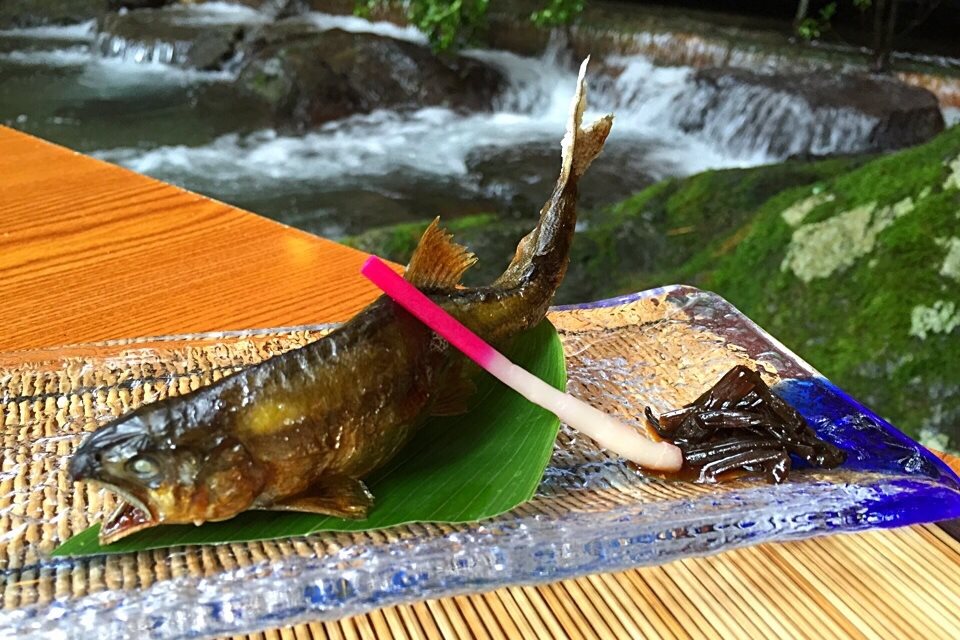
The heat of summer affects nearly everyone’s appetite. But there are foods that are just perfect for a hot day when you don’t have much appetite and here they are. Japanese cuisine has more to offer than you might know. Learn more!
Soba buckwheat noodles: The best soba restaurants are usually small, and serve fresh, handmade teuchi soba. Though the menus are usually only in Japanese, a few key words are all you need. Cold noodles (tsumetai ho) offer a number of choices. For cold soba, plain and simple, order zaru soba. Named for the bamboo rack on which they are served, these noodles come with a small bowl of tsuyu, fish broth flavored with soy sauce and rice wine, to which you add hot green horseradish (wasabi) and chopped green onions. Another popular choice is tenzaru : cold noodles served with hot, batter-fried shrimp and vegetables. If you decide on hot noodles, try nishin soba (herring) or tempura soba (served with batter-fried shrimp), kitsune soba (served with strips of fried tofu). Add a pinch of shichimi, a blend of seven hot spices, if you wish to sweat a bit more. [see section below for more July noodle cuisine details]
Ayu river trout & eel cuisine: July is also river fish and eel season. Ayu, a small kind of river trout, are beautiful and tasty. Hamo (sea eel) and unagi (river eel) are big summer favorites as they are said to cool the body.
Outdoor river dining platform: One riverside experience that everyone should try is yuka dining (unique to Kyoto) on the wooden dining platforms that extend out from restaurants on the west side of the river between Gojo and Oike. Yuka developed in the 16th century. And Kibune village, just north of Kyoto by tram, is also super famous and popular for outdoor, over-the-river dining.
July vegetables and fruits: Edamame green soybeans are wellknown abroad as a starter dish in traditional Japanese restaurants and they are in season big time in July. For veggies look for some of the year's best kyuri cucumbers and nasu eggplant dishes. And in the fruit category you will find lots of amazing July suika watermelon and honey melons as well as the first Japanese budo grapes (small and slightly tart!)
Japan July travel tree and flower highlights
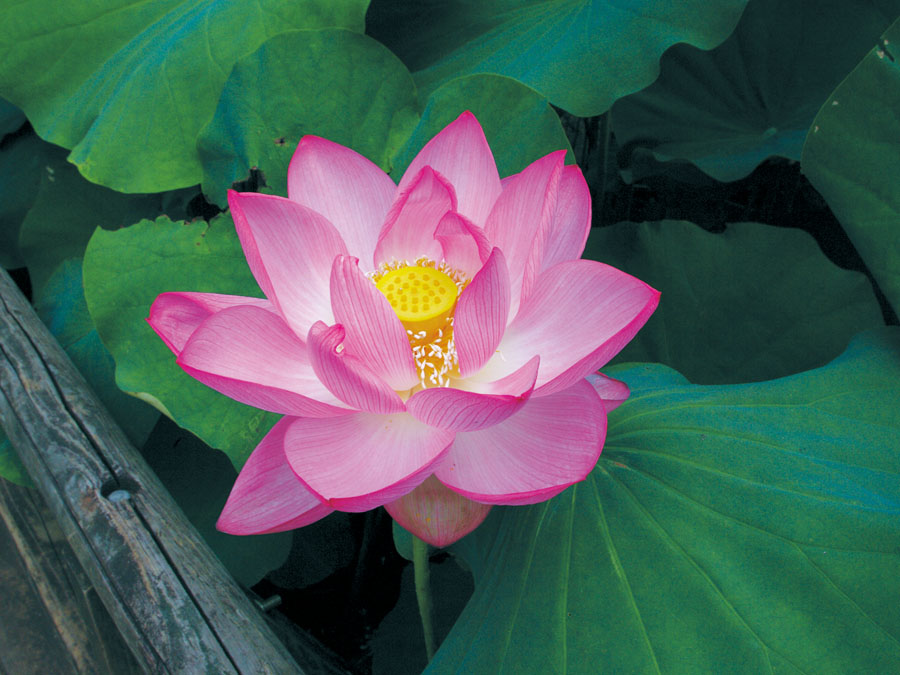
The Lotus Flower: The lotus (hasu) flower springs forth out of the mud in ponds across Japan in July (earlier in Kyushu and later in the Kansai-Kanto coastal regions. These exquisite large pink or white flowers last for about four days in the intense summer heat (right through mid-August). The flowers open at dawn and close by mid-afternoon. Its short-lived blossom suggests reincarnation; the wheel-like leaves and spike-shaped petals imply the perpetual cycle of existence; and the pure flowers rising from the mud symbolize Buddhist enlightenment for anyone. Lotus seeds are often used as Buddhist rosary beads. Even after blooming, the lotus is beautiful. The seed pod has a distinctive, honeycomb shape, while the large leaves retain their deep green. The roots (renkon) are edible and are used in numerous Japanese dishes.
Hydrangea ajisai: Hydrangea begin flowering in June and can be experienced all over Japan in July (until about mid-July at sea level and later higher up in the mountains). The most famous locations are Yatadera Temple, Nara; and Hasedera Temple, Kamakura.
Morning Glory Asagao: Morning Glories or Asagao bloom throughout July and August and are the favourite display flower in the front gardens of traditional homes and at major botanical gardens all over the country. In particular, the area of Iriya in Tokyo is very famous for its floral markets. Every year in July, there is an open market with nearly 100 flower shops known as the Iriya Morning Glory Festival (first week in July) at Iriya Kishimojin temple that attracts about 400,000 visitors over the weekend, who come to admire and buy morning glories. It starts early in the morning so that you can see the morning glories fresh and in full bloom.
Sunflowers: Sunflowers are hugely popular in Japan and can be seen in a few places around Tokyo and, best of all, in Hokkaido. The big field venues for sunflowers are the Hokuryu Sunflower Village (Hokkaido); Kiyose Sunflower Festival (Tokyo); and the Yamanakako Hanano Miyako Park (Mount Fuji, Yamanashi prefecture).
Furano flower fields (Hokkaido): Hokkaido and its enormous wide open spaces is super famous in summer in general and for its flowers in spring, summer and autumn. No place is more famous and more posted on Instagram than the Furano flower fields.
- Japan July travel food highlights
- Japan July travel tree and flower highlights
- Japan July travel festival highlights
- Summer Noodles: Cool, tasty, light and healthy!
- Tanabata: A party for children & an eternal fairytale for everyone
- July Gion Matsuri Interview With A Priest At Yasaka Shrine
Japan July travel festival highlights
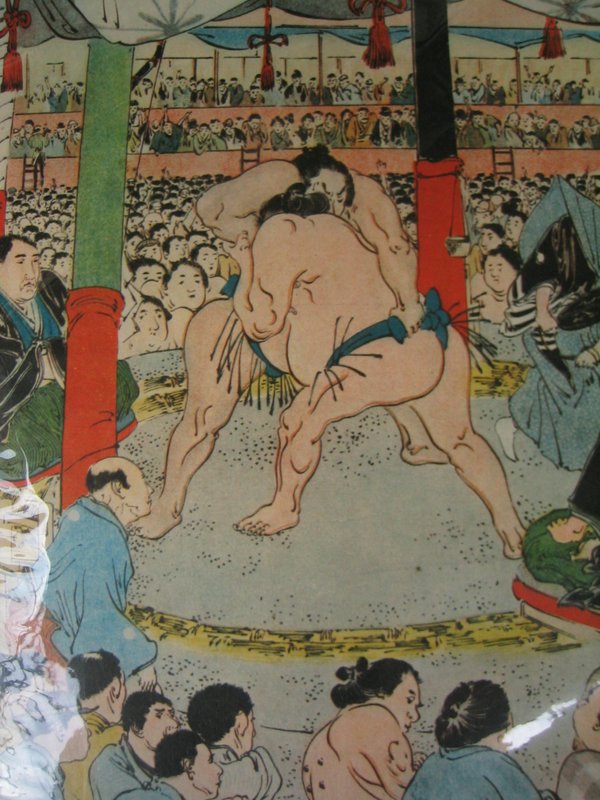
Gion Matsuri (July 1 to July 29, Kyoto): The Gion Matsuri is a long, elaborate festival in Kyoto that occupies the entire month of July. The peak is the Yamaboko Junko (float parade) on July 17th and July 24th. The floats can weight over 12,000 kilograms. They're quite a sight. Tanabata Festival (July 7, multiple locations across Japan): Tanabata is a festival of star-crossed lovers that's celebrated by writing wishes on long colorful strips of paper and hanging them from bamboo branches. Mount Fuji Climbing Season (July 10 to September 10, Mount Fuji): Mount Fuji climbing season begins in July. The opening date varies by year depending on the weather. Climbing Mount Fuji is somewhat challenging, and some people experience altitude sickness. The trails, facilities and peak can be surprisingly crowded. Nevertheless, it's usually a memorable experience that instils a sense of accomplishment. Sumo Nagoya Basho (early to mid-July, Nagoya): One of the 6 Grand Championships of Sumo wrestling. A chance to see the stars of the sport at their most competitive. Sapporo Summer Festival (mid-July to mid-August, Sapporo): A variety of summer events in Sapporo that are packaged into a single festival that lasts a month or more. Events include Obon dances, firefly hunts, and fireworks. Tenjin Matsuri (July 24-25, Osaka): Osaka's biggest summer festival features fireworks, mikoshi floats carried through the streets, geisha, river boat bonfires, and a parade of 3000 people in 8th century Imperial court costume. Hakata Gion Yamakasa (July 10-15, Fukuoka): This five-day festival attracts over a million people every year and builds up to an early morning race of heavy floats from 7 competing districts through the streets of Fukuoka. Mushi Barai Treasure Display (July 25, 29, 30, Kyoto): A special chance to see about 200 treasures aired out (to prevent insect damage) after rainy season. At Shinnyo-do Temple for rare Buddhist artworks on July 25. And at the Kongo Noh Theatre on July 29 and 30 for noh masks, costumes and instruments. Shinjuku Eisa Festival (late July, Tokyo): A celebration of the culture and dance of the Okinawan Islands in one of Tokyo's biggest neighborhoods. Sumidagawa Fireworks (last Sat in July, Tokyo): The world's oldest fireworks show in the historic Asakusa district of Tokyo. Hiwatari-sai Fire Walk (July 28, Kyoto): In this purification ceremony, which is said to ward off illness, wooden prayer sticks (goma) are burned at 19:00, and people walk across the coals. Free paper talismans are presented to those who complete the ceremony. Tanukidani Fudo-in Temple, just above Shisen-do Temple. Sennichi Mairi Annual Night Walk Up Mt. Atago (July 31, Kyoto): on this night, thousands of pilgrims climb Mount Atago in an annual spiritual event known as Sennichi-mairi. One trip to Atago Shrine (at the summit) on this date earns you the equivalent of 1,000 visits! People from all over Japan have climbed this peak for centuries to obtain a fire protection amulet. The last trains for Arashiyama on the Keifuku line leave Shijo-Omiya at 23:45. Special shuttle buses will also run from Arashiyama Station to Kiyotaki (20 min) in the evening until around midnight. There will be no public transportation back to the city until dawn, so plan on returning by taxi. Fuji Rock Festival (late July, Naeba Ski Resort, Niigata): This legendary music festival attracts top international artists and 100,000 fans for three days and nights of music and camping.
Summer Noodles: Cool, tasty, light and healthy!
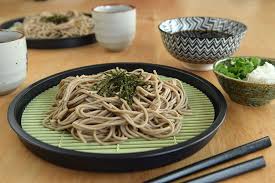
One of the really fun things about Japanese summer, which can be hotter and more humid than you have ever experienced, are chilled noodles. They are available everywhere and they are not expensive and they are just the right amount when your appetite flags in the heat and humidity. And remember, it’s considered polite to slurp your noodles. So don’t be shy. Enjoy yourself. Soba (buckwheat noodles): The chilled soba (tsumetai ho) favourites are: zaru soba (plain chilled soba noodles); tenzaru soba (chilled noodles served with hot, batter-fried shrimp and vegetables). All zaru soba variations come with tsuyu, fish broth flavored with soy sauce and rice wine, to which is added a touch of hot green horseradish (wasabi), and chopped green onions. Nagashi Somen: From late May or early June in green, riverside Kibune, a thirty minute ride north on the Eizan railway line from Kyoto, you can enjoy nagashi, or "flowing", somen, chilled noodles sent down a long bamboo chute to where you are sitting (each order comes in 6 or 7 little packets, that you have to catch with you chopsticks; left handers beware: noodles fly in from the left and can be hard to stop; use your hand if you have to). This meal can be unbelievably fun. Two places offer nagashi somen in Kibune, both are at the north end of the village: Hirobun (this is the best place!) and Sagenta. Reimen: Reimen is a popular Chinese summer noodle dish featuring chilled, cooked ramen noodles topped with sliced cucumbers, ham or pork, egg, and a bit of spicy hot, yellow mustard. Dip all this in a pre-made tangy blend of vinegar, sesame oil, and soy sauce.
- Japan July travel food highlights
- Japan July travel tree and flower highlights
- Japan July travel festival highlights
- Summer Noodles: Cool, tasty, light and healthy!
- Tanabata: A party for children & an eternal fairytale for everyone
- July Gion Matsuri Interview With A Priest At Yasaka Shrine
Tanabata: A party for children & an eternal fairytale for everyone
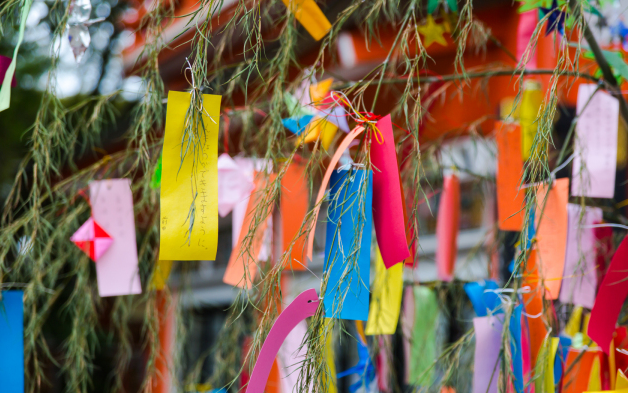
Tanabata, the Star Festival, is a holiday for Japanese children celebrated on July 7th. In the lunar calendar, the two most luminous stars of the summer sky Vega (in the constellation Lyra), and Altair (in the constellation Aquila) cross paths on this day. There’s an enduring myth in China and Japan about these two stars, where one is a beautiful young woman (Orihime, the Weaving Princess, in Japan) who weaves, and the other is a strong, young shepherd man (Kengyu in Japan). She was the most beautiful single woman in all the land, known for her weaving skills. They fell in love, married and soon began to do nothing but play together. She forgot her weaving and he forgot his herds. The Gods, angry with their selfish love and disrespect punished the two: allowing them to meet only once a year. Once a year, on July 7th, they cross the Milky Way on the back of Cygnus, the heavenly swan, and see each other for a few hours.
Japanese children celebrate Tanabata by praying for good weather and writing their wishes on strips of paper which they tie to branches of bamboo, decorated with a colorful range of origami folded-paper birds, etc. These are hung outside the home. In the old days, a young woman would hang out examples of her own sewing work or calligraphy. Tanabata festivals are common all over Japan in the first 10 days of July!
July Gion Matsuri Interview With A Priest At Yasaka Shrine
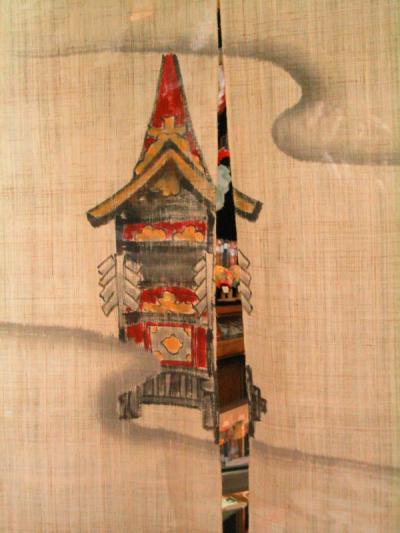
This interview was conducted in July 1997 at Yasaka Shrine. The shrine is one of Kyoto’s oldest. It was founded in 876 AD and until 140 years ago was known as Gion-sha, the first of many Gion shrines located throughout Japan. The shrine's history began when the god that prevents illness was invited to the shrine as a measure to stop a devastating series of epidemics and other natural disasters plaguing Kyoto at that time. This was the origin of the important Gion Matsuri festival. The shrine’s present-day Main Hall (an Important Cultural Property), last reconstructed in 1654, is a rare example of the Gion-zukuri architectural style. The West Gate (also an Important Cultural Property) facing Higashiyama Street, dates from the Muromachi period (1336-1573). Today, the shrine adds an impressive and even magical touch of antiquity to the busy intersection of Shijo and Higashiyama, located on the eastern edge of the Gion geisha night district. But in July the shrine is absolute spiritual center of the month-long Gion festival, the biggest in Japan and maybe even the most interesting.
YJPT: How long have you been involved with the Gion Festival?
Tsuji-san: Directly, I have been involved for about fourteen years. In the months leading up to the festival, more than half of my time is taken up with preparations. We don’t get much time for holidays at this time of year. In fact, during May, June, and July we have almost no breaks, at all. Sunday, is one of our busiest days.
YJPT: What is the main deity of Yasaka Shrine? What kinds of things do you serve the kami-sama [god]? Do these things change each year? And how does Yasaka Shrine relate to other shrines throughout Japan?
Tsuji-san: We are the parent shrine of a loose affiliation of Japanese shrines that worship Susanoo, a multifaceted deity with contradictory characteristics associated with the sea and storms, or as a local deity linked with the harvest and agriculture. There are many things that we give to the kami-sama, but the fundamental things — rice, sake, salt, and water — never change. These things are absolutely necessary. Aside from that, we sometimes give omochi [rice cakes], tai [sea bream], vegetables, or fruits. The are no absolute rules governing what can and cannot be given. Every festival is different like every season is unique.
YJPT: What kinds of clothing do you wear during the festival?
Tsuji-san: There are a number of different ranks within the sacred Shinto profession, and the clothing worn varies with one's position. The clothing also varies with each festival. For the Gion Matsuri we use Heian-period noble’s clothes. These robes are woven of flax and are very long. However, we fold them up, and wear them in a shortened fashion. There are black, red, and blue robes. Black is the highest and blue the lowest, in terms of rank.
YJPT: Is there anything in particular you would like to say to our readers about the festival?
Tsuji-san: Yes. The first thing I would like to make clear is that the Gion Festival continues throughout the month of July. The parade on July 17th is just one of many smaller rituals that comprise the entire event. Secondly, I would very much like to emphasize that Japanese festivals are sacred acts, and essentially and clearly defined rituals. The word festival conveys the wrong idea, and I would like to stress to your readers that they try not to forget the underlying and highly sacred nature of this festival and others in Japan. Too many people, and this also includes my people, have forgotten this or simply never knew.
YJPT: Yes, it’s almost like there are no taboos, or sacred awareness in this day and age. Today, our laws are the taboos. But, from a Shinto point of view there are many taboos, are there not?
Tsuji-san: Many. Some are essentially “Japanese” taboos. But most young Japanese people seem to have forgotten these important matters. In fact, they seem to have forgotten a great part of the origins and history of their own country and culture. They simply know too little of these things, and one must wonder about the effectiveness or wisdom of education and parenthood in today's culture. Ironically, it seems that foreigners have a greater sense of Japanese culture.
YJPT: Tell me a little bit about yourself. What are your favorite places in Kyoto? Do you have any hobbies?
Tsuji-san: Well, since I live in Kyoto, I like quiet places. For instance, I like Sanzen-in Temple or Kurama Temple. But in the off season. I especially like Ohara and Sanzen-in in the winter when there are hardly any tourists at all. As far as hobbies go, I have been involved in gagaku [Japanese court music] since college, but I do not have much time to do it, now. I play the sho [bamboo flute] and I try my best to spend as much time at it as I can.
Japan month by month private travel & culture summary index
Japan spring travel: Mar, April, May. Learn more!
Japan summer travel: June, July, August. Learn more!
Japan autumn travel: Sept, Oct, Nov. Learn more!
Japan winter travel: Dec, Jan, Feb. Learn more!
Content by Ian Martin Ropke, owner of Your Japan Private Tours (est. 1990). I have been planning, designing, and making custom Japan private tours on all five Japanese islands since the early 1990s. I work closely with Japan private tour clients and have worked for all kinds of families, companies, and individuals since 1990. Clients find me mostly via organic search, and I advertise my custom Japan private tours & travel services on www.japan-guide.com, which has the best all-Japan English content & maps in Japan! If you are going to Japan and you understand the advantages of private travel, consider my services for your next trip. And thank you for reading my content. I, Ian Martin Ropke (unique on Google Search), am also a serious nonfiction and fiction writer, a startup founder (NexussPlus.com), and a spiritual wood sculptor. Learn more!